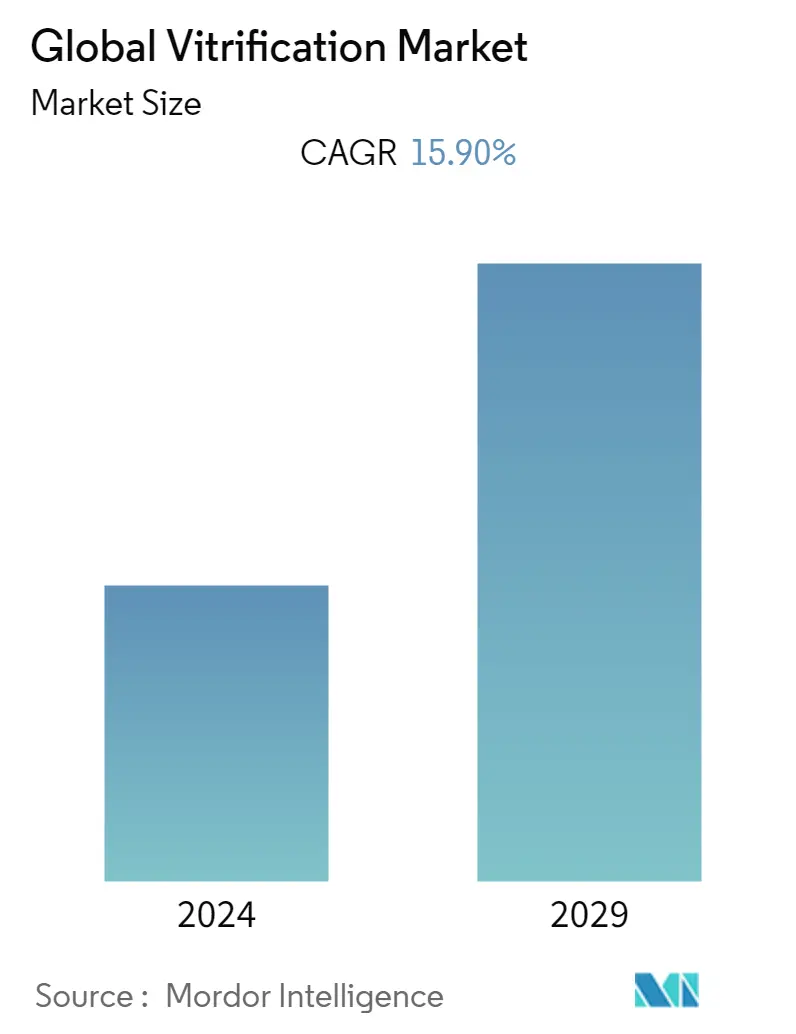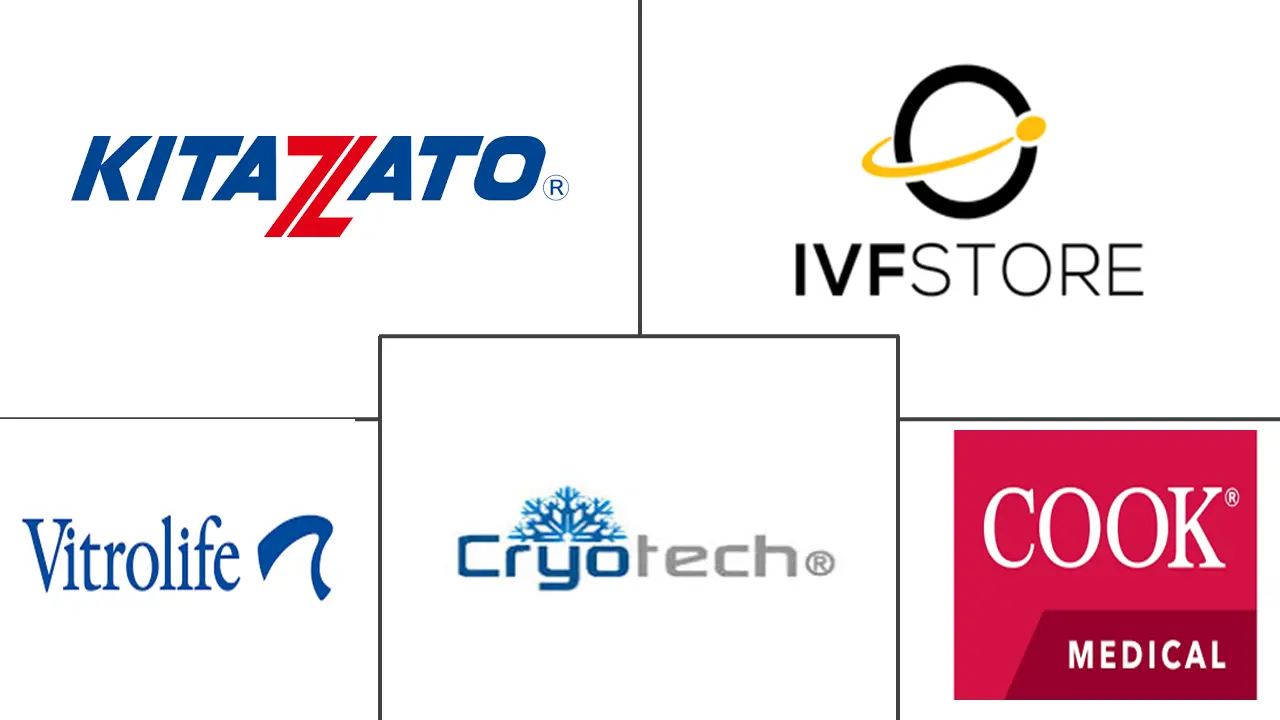Market Size of Global Vitrification Industry

| Study Period | 2019 - 2029 |
| Base Year For Estimation | 2023 |
| CAGR | 15.90 % |
| Fastest Growing Market | Asia-Pacific |
| Largest Market | Europe |
| Market Concentration | Medium |
Major Players
*Disclaimer: Major Players sorted in no particular order |
Vitrification Market Analysis
The vitrification market is projected to register a CAGR of 15.9% during the forecast period (2021-2026).
During the Covid-19 pandemic, scientific groups such as the European Society for Human Reproduction and Embryology and the American Society for Reproductive Medicine have issued advice and guidelines to help people who are undergoing in-vitro fertilization treatments overcome and flatten the infection curve. There is no significant impact of Covid-19 on the vitrification market, as the process involves controlled procedures, that reduce the risk of contamination of the samples during vitrification and storage. They can successfully reduce the danger of cross-contamination and infection caused by the current Covid-19 pandemic or other viral exposures.
Many factors are propelling the market growth, some of them include, growth in fertility preservation techniques delayed childbearing due to sociodemographic factors, and increasing awareness of reproductive health among people. Several studies and trials have been undertaken to demonstrate the efficacy of vitrification over slow freezing, resulting in its expanded clinical use. Most Invitro Fertilization (IVF) clinics are currently employing this procedure to freeze eggs/embryos and provide a better success rate to patients, which is driving the industry. Besides this, various firms provide cost-effective specimen preservation services, which expands the vitrification market's potential
Furthermore, delayed childbearing is due to sociodemographic factors is also contributing to the vitrification market. Delayed childbirth is a significant shift in reproductive behavior that affects all developed countries. This has increased the number of births among women in their forties and fifties. For instance, according to a study published in 2019 in Cairn.info, a French-language web portal of humanities and social sciences, infertility rates rise rapidly, with the percentage of women who are unable to conceive rises from 17% at age 40 to 56% at age 45. To overcome this problem and postpone their parenthood, people are inclined towards vitrification. For instance, according to the Centers for Diseases Control and Prevention (CDC), in 2019, 448 reporting clinics in the United States executed 330,773 Assisted Reproductive Technology (ART) cycles, resulting in 77,998 live births (delivery of one or more living newborns) and 83,946 live-born infants. In 2019, 121,086 of the 330,773 ART cycles were egg or embryo banking cycles, in which 100% of the resultant eggs or embryos were saved for future use. Therefore, delayed parenthood in developed countries resulted in an inclination towards vitrification, which in turn boosts the market growth.
Vitrification Industry Segmentation
As per the scope of this report, vitrification is a technique used in the freezing of embryos and eggs so that they can be kept for later use. Vitrification techniques are useful for preserving cells and tissues, and it has a wide range of uses in reproductive biology and regenerative medicine. It is used in human fertility preservation, cell storage for tissue regeneration, cell therapy, and gamete and embryo banking, among other things. The vitrification market is segmented By Specimen (Oocytes (Devices and Kits & Consumables), Embryo (Devices and Kits & Consumables), and Sperm)), By End User (IVF Clinics and Biobanks), and Geography (North America, Europe, Asia-Pacific, Middle East and Africa, and South America). The vitrification market is projected to register a CAGR of 15.9% during the forecast period. The market report also covers the estimated market sizes and trends for 17 different countries across major regions, globally. The report offers the value (in USD million) for the above segments.
| By Specimen | ||||
| ||||
| ||||
| Sperm |
| By End User | |
| Invitro Fertilization Clinics | |
| Biobanks |
| Geography | ||||||||
| ||||||||
| ||||||||
| ||||||||
| ||||||||
|
Global Vitrification Market Size Summary
The vitrification market is experiencing significant growth, driven by advancements in fertility preservation techniques and increasing awareness of reproductive health. The process of vitrification, which involves rapidly freezing eggs and embryos, has gained popularity due to its superior success rates compared to traditional slow freezing methods. This technique is particularly beneficial for women delaying childbirth for sociodemographic reasons, as it helps preserve fertility and overcome challenges associated with advanced maternal age. The market is further bolstered by the availability of cost-effective specimen preservation services and the growing number of IVF clinics adopting vitrification to enhance patient outcomes. Despite the Covid-19 pandemic, the market has remained resilient, with controlled procedures minimizing contamination risks.
Europe is poised to dominate the vitrification market, supported by rising infertility rates, increased public awareness of fertility treatments, and technological advancements. The region's well-established IVF clinics and favorable healthcare infrastructure contribute to its leading position. Key players in the market, such as Kitazato Corporation, IVF Store, and Vitrolife, are actively enhancing their offerings through strategic acquisitions and partnerships, further strengthening their market presence. The market is moderately fragmented, with a few major players holding significant shares. The ongoing demand for oocyte vitrification, driven by its high success rates and the inclination of women to preserve fertility for medical or personal reasons, is expected to sustain the market's growth trajectory.
Global Vitrification Market Size - Table of Contents
-
1. MARKET DYNAMICS
-
1.1 Market Overview
-
1.2 Market Drivers
-
1.2.1 Growth in Fertility Preservation Techniques
-
1.2.2 Delayed Childbearing due to Sociodemographic Factors
-
1.2.3 Increasing Rate of Infertilities
-
1.2.4 Increasing Awareness in Reproductive Health
-
-
1.3 Market Restraints
-
1.3.1 Ethical Concerns About The Preservation of Eggs and Sperms
-
-
1.4 Porter's Five Force Analysis
-
1.4.1 Threat of New Entrants
-
1.4.2 Bargaining Power of Buyers/Consumers
-
1.4.3 Bargaining Power of Suppliers
-
1.4.4 Threat of Substitute Products
-
1.4.5 Intensity of Competitive Rivalry
-
-
-
2. MARKET SEGMENTATION
-
2.1 By Specimen
-
2.1.1 Oocytes
-
2.1.1.1 Devices
-
2.1.1.2 Kits & Consumables
-
-
2.1.2 Embryo
-
2.1.2.1 Devices
-
2.1.2.2 Kits & Consumables
-
-
2.1.3 Sperm
-
-
2.2 By End User
-
2.2.1 Invitro Fertilization Clinics
-
2.2.2 Biobanks
-
-
2.3 Geography
-
2.3.1 North America
-
2.3.1.1 United States
-
2.3.1.2 Canada
-
2.3.1.3 Mexico
-
-
2.3.2 Europe
-
2.3.2.1 Germany
-
2.3.2.2 United Kingdom
-
2.3.2.3 France
-
2.3.2.4 Italy
-
2.3.2.5 Spain
-
2.3.2.6 Rest of Europe
-
-
2.3.3 Asia-Pacific
-
2.3.3.1 China
-
2.3.3.2 Japan
-
2.3.3.3 India
-
2.3.3.4 Australia
-
2.3.3.5 South Korea
-
2.3.3.6 Rest of Asia-Pacific
-
-
2.3.4 Middle-East and Africa
-
2.3.4.1 GCC
-
2.3.4.2 South Africa
-
2.3.4.3 Rest of Middle-East and Africa
-
-
2.3.5 South America
-
2.3.5.1 Brazil
-
2.3.5.2 Argentina
-
2.3.5.3 Rest of South America
-
-
-
Global Vitrification Market Size FAQs
What is the current Global Vitrification Market size?
The Global Vitrification Market is projected to register a CAGR of 15.90% during the forecast period (2024-2029)
Who are the key players in Global Vitrification Market?
Kitazato Corporation, IVF Store, Vitrolife, Cryotech and COOK MEDICAL LLC are the major companies operating in the Global Vitrification Market.

